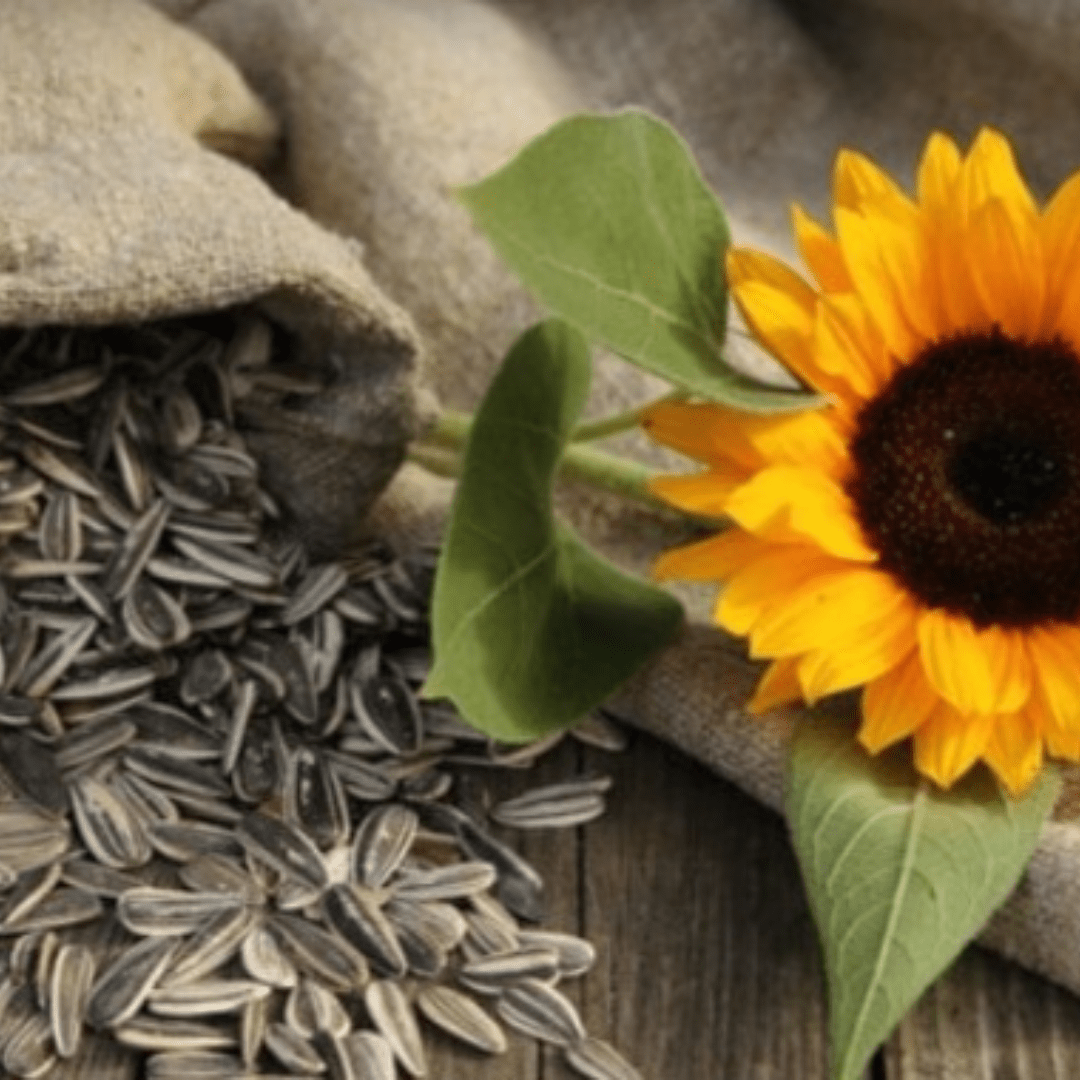Learn how to harvest sunflower seeds like a pro with this ultimate guide. From knowing the perfect time to cut your sunflowers to drying and storing the seeds, I’ll walk you through every step. Whether you’re saving them for replanting, roasting for snacks, or feeding birds, these easy tips ensure a bountiful and tasty harvest.
There’s something magical about standing in the middle of a sunflower patch, watching those golden heads bow under the weight of their seeds. It’s a little like nature’s way of saying, “Here’s your reward for a season well spent.” Harvesting sunflower seeds isn’t just about getting a snack (although roasted sunflower seeds are a real treat) — it’s about closing the loop in your garden, saving seeds for next year, and feeding your family or even your flock.
Over the years, I’ve learned the little signs that tell me it’s time to harvest, the easy ways to keep the seeds from molding, and the best ways to store them so they stay fresh. Let’s walk through it together, barefoot in the garden, from flower to seed jar!
This is a pinnable post. Tap or hover over any image in this post to pin to your Pinterest Boards.
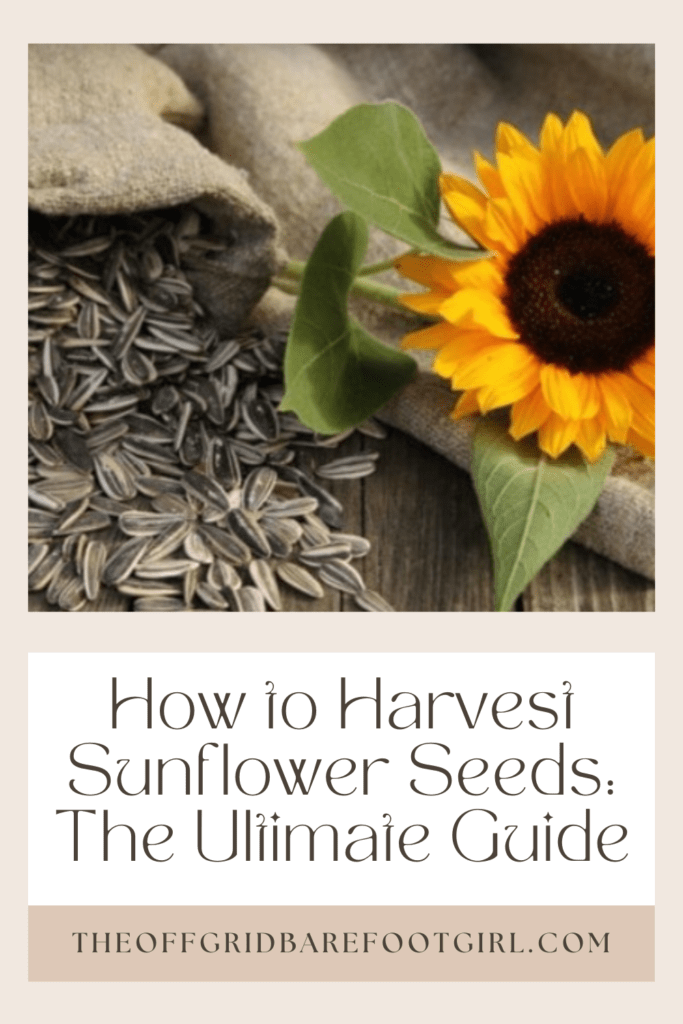
Introduction to Harvesting Sunflower Seeds
Why I Grow Sunflowers In My Garden
I grow sunflowers because they bring me immeasurable joy and add a burst of vibrant colors to my garden. There’s something magical about witnessing these magnificent flowers sprout from tiny seeds into towering giants that seem to reach for the sky. The whole process, from planting the seeds to nurturing the plants, makes me feel connected to Mother Nature and fuels my love for gardening. Moreover, sunflowers attract bees, butterflies, and birds, turning my garden into a lively ecosystem. It’s truly captivating to see different creatures visiting these sunny beacons and witnessing the symbiotic relationship between them.
In addition to their beauty and ecological benefits, sunflowers provide a source of nutritious seeds that I can use in cooking or share with local wildlife. All in all, growing sunflowers is an enriching experience as it not only beautifies my surroundings but also creates an environment conducive to biodiversity while providing sustenance for various creatures around me.
Understanding the Benefits of Harvesting Your Own Sunflower Seeds
Harvesting sunflower seeds is like finding a hidden treasure in your backyard. Not only do you get to enjoy the vibrant beauty of these sunny blooms, but you also get to reap the rewards of your own homegrown snack. Think of it as a win-win situation: you get to satisfy your snacking cravings while basking in the pride of growing your own food. Plus, let’s not forget about the cost savings. Store-bought sunflower seeds can be pricey, but by harvesting your own, you can literally save some money.
I like to fill bird feeders with the sunflower seeds that I grow and harvest. I hang the feeders in my large tree right in front of my living room window, where I can watch the birds enjoy them all winter long.
The Stages of Sunflower Growth and When to Harvest
Like any good harvest, timing is key when it comes to sunflower seeds. So, let’s quickly walk through the sunflower growth stages. First, there’s the cute sprouting stage, where little green leaves burst through the soil. Then, your sunflower plant grows taller and taller, reaching for the sky like an ambitious overachiever. Finally, the moment arrives when the petals begin to dry out, and the center of the sunflower head transforms into a glorious smorgasbord of seeds.
But when is the right time to swoop in for the harvest? Ah, the million-dollar question! You’ll know it’s time when the backside of the sunflower head turns yellowish-brown and the petals start to fall off. That’s nature’s way of telling you, “Hey, buddy, the seeds are ready to be snatched!” So prepare your gardening gloves and get ready to embark on a sunflower seed harvesting adventure.
Selecting the Right Sunflower Variety for Seed Harvesting
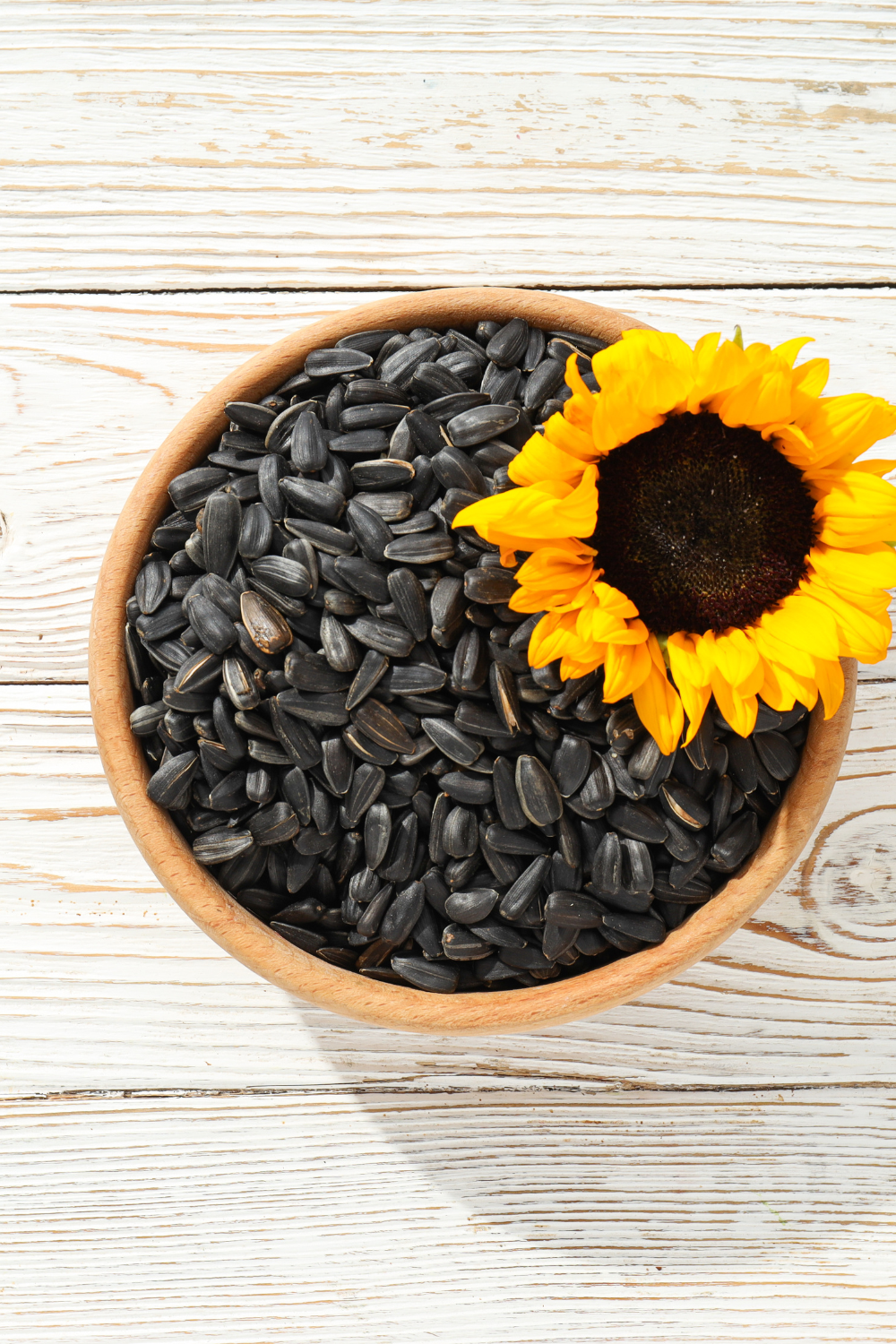
Determining Seed-Specific Sunflower Varieties
Not all sunflowers are created equal when it comes to harvesting seeds. Some varieties are bred specifically for their delicious and plump seeds, while others prioritize stunning blooms. To ensure a bountiful harvest of seeds, look for sunflower varieties labeled as seed-specific or oilseed sunflowers. These beauties have been bred to produce larger seeds and have a higher oil content. They’re like the sunflower MVPs in the seed department.
Considering Climate and Growing Conditions
Sunflowers are hardy plants that can thrive in various climates, but it’s still important to choose the right variety based on your local weather conditions. If you live in a region with shorter summers, opt for early-maturing varieties that can reach seed maturity faster. On the other hand, if you have a longer growing season, you can experiment with larger varieties that take their sweet time to develop those delectable seeds. So, take a peek at your local climate and choose a sunflower variety that will make both you and Mother Nature happy.
Preparing the Sunflowers for Seed Harvesting
Preparing the Soil and Planting Sunflower Seeds
Before you can enjoy the satisfaction of harvesting sunflower seeds, you’ll need to lay the groundwork for success. Start by preparing the soil in your chosen growing area. Sunflowers prefer well-draining soil, so loosen it up using a garden fork or tiller. Add some compost or organic matter to give those seeds a nutrient boost. Then, it’s time to sow the seeds. Plant them about 1 to 2 inches deep and give them some room to spread their roots by spacing them around 6 to 12 inches apart. Pat the soil gently but firmly, like you’re giving it a reassuring high-five.
Nurturing Sunflower Plants for Optimal Seed Production
Now comes the part where you shower your sunflower plants with love and attention. Water them regularly, making sure the soil stays consistently moist, but not soaking wet. If you notice any pesky weeds trying to steal the limelight from your sunflowers, pluck them out to keep the competition at bay. And since sunflowers are like mini celebrities, you might want to consider staking them for support, especially if you’re growing larger varieties. Think of it as giving them their very own red carpet treatment.
Enjoying Growing Sunflowers Throughout the Season
I just love the joy and excitement that come with growing sunflowers throughout the season. It’s like having a front-row seat to witness nature’s incredible masterpiece unfold right in my backyard. From planting the seeds and nurturing them with care to seeing those tiny green sprouts bravely push through the soil, every step of the process brings me immense pleasure. Watching these majestic plants grow taller and taller each day is truly awe-inspiring. And let’s not forget about those radiant yellow faces that never fail to put a smile on my face!
Whether it’s basking in their vibrant beauty during a sunny afternoon or marveling at how they sway gracefully in the breeze, there’s an undeniable charm to these glorious flowers that never fails to captivate me. Sunflowers are like little bursts of sunshine that add warmth and happiness to any garden or home. So why not embrace this simple pleasure and let yourself be enchanted by their journey?
Techniques and Tools for Harvesting Sunflower Seeds
Identifying Signs of Sunflower Seed Maturity
When it comes to harvesting sunflower seeds, timing is everything. The good news is, that the sunflower head knows how to give you some obvious hints. Look for those telltale signs of maturity, such as the backside turning a lovely shade of brown and the seeds appearing plump and well-developed. If you come across any seeds that look shriveled or underdeveloped, they’re not ready for prime time just yet. Leave those flowers be and come back for them later.
Harvesting Sunflower Heads
Once you’ve confirmed that your sunflower heads are ripe for the picking, it’s time for the thrilling part: the actual harvest. Grab a sharp pair of shears or pruners, and carefully cut the sunflower head off the main stalk. Aim for a clean cut, just like a hairdresser giving a perfect trim. Don’t worry if you accidentally snip off a few extra leaves or stems; it’s all part of the process. Now, hold that sunflower head up triumphantly, and let the cheering commence!
Threshing and Separating Seeds from the Flower Heads
Now that you’ve amassed a glorious collection of sunflower heads, it’s time to separate those precious seeds from their lovely flower homes. One popular method is to lay the sunflower heads on a clean cloth or tarp and let them dry in a well-ventilated area. As they dry, gently rub the flower heads with a gloved hand or use a tool like a fork to loosen the seeds. You’ll find that the seeds effortlessly separate from the flower head as if they’re eager to be set free. Once you’ve unleashed those seeds into a jar, give them a final check for any remaining debris, and voila! Your sunflower seeds are ready to fulfill their destiny as a tasty snack.
Properly Drying and Storing Sunflower Seeds
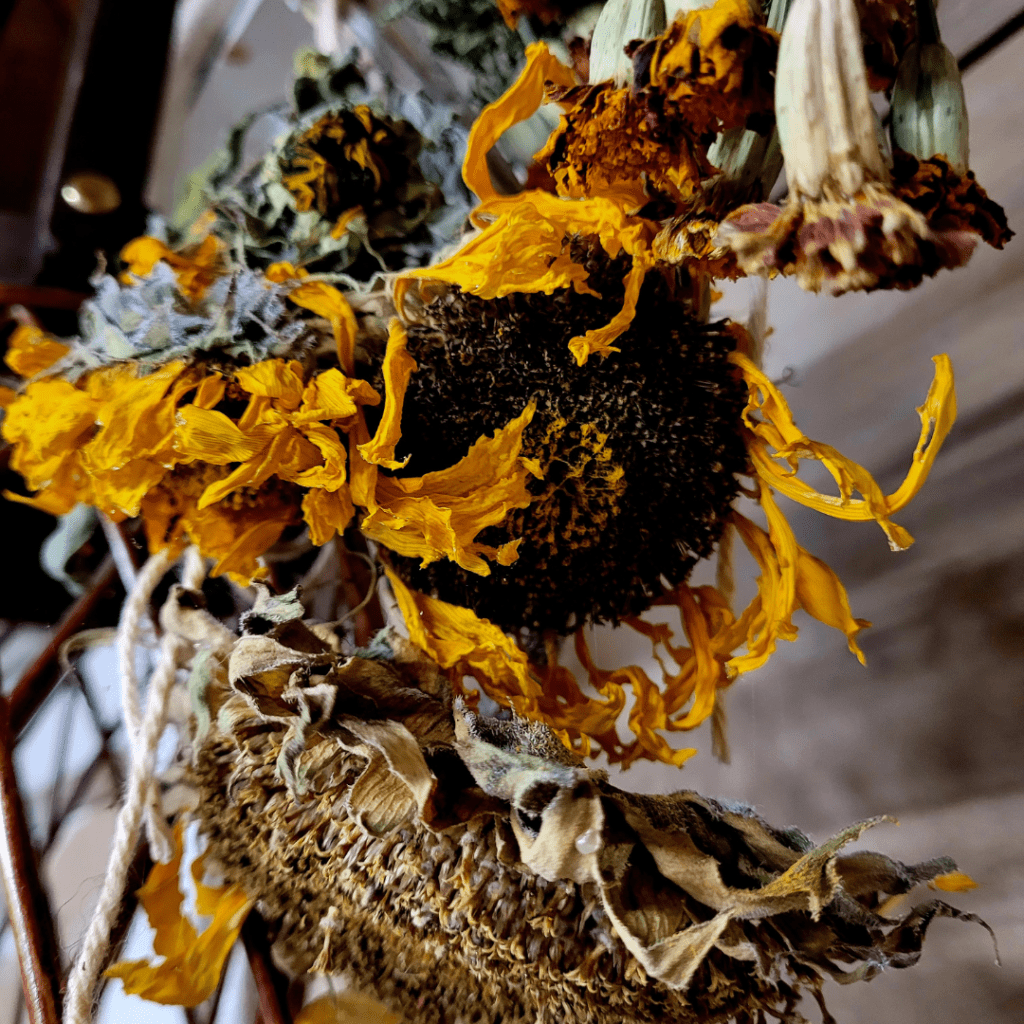
Drying Sunflower Seeds to Optimal Moisture Levels
When it comes to harvesting sunflower seeds, the drying process is crucial for ensuring their longevity and flavor. Once the seeds are removed from the flower heads, spread them out in a single layer on a clean, dry surface. Avoid stacking them on top of each other like a game of sunflower Jenga. Allow the seeds to air dry for about a week, gently stirring them every day to prevent any clumping or mold growth. You’ll know they’re properly dried when the seeds feel firm and break with a crisp snap rather than bending.
I make sure I do this process outside on my back patio on a table. This is because I have found that sunflowers hide a ton of bugs and I do not want to bring them inside! The sunflower heads will dry out nicely in the sun for a few days and the bugs will find their way out of the flowers naturally.
Selecting Suitable Storage Containers and Conditions
Once your sunflower seeds are fully dried, it’s time to store them properly to maintain their freshness. Choose storage containers that are airtight and made of glass or metal. Plastic containers can be a magnet for unwanted moisture, not to mention those pesky pantry moths that seem to infiltrate everything. Keep the seeds in a cool, dark place to prevent them from going rancid. Avoid storing them near strong-smelling foods, as sunflower seeds can easily absorb odors like a sponge. With proper storage, your sunflower seeds can stay deliciously edible for up to a year.
I keep my harvested sunflower seeds in recycled glass jars stored in my cool, dark basement pantry. Once the seeds are dried out, I place them in the glass jar for safekeeping until I am ready to use or plant them.
Tips and Tricks for Maximizing Sunflower Seed Yields
Enhancing Sunflower Plant Health and Growth
If you want to take your sunflower seed game to the next level, it’s important to pay attention to your plant’s health and well-being. Provide them with plenty of sunlight, nutrient-rich soil, and water regularly, but not too much, because nobody likes soggy roots. Consider adding organic matter like compost or well-rotted manure to the soil before planting to give your sunflowers a nutrient boost. And don’t forget to show your sunflowers some love and affection. Compliment them on their height, tell them they’re blooming lovely.
Optimizing Seed Production Through Timing and Spacing
Timing is everything when it comes to maximizing your sunflower seed yield. Plant your sunflower seeds after the last frost date in your area, or when the soil temperature reaches around 50°F (10°C). This way, your seeds won’t shiver in the cold and their growth will be as smooth as butter. To optimize seed production, make sure to give your sunflowers enough space to spread their leafy arms. Plant them about 2 to 3 feet apart, so they don’t start elbowing each other for sunlight and nutrients. Trust me, nobody likes a sunflower brawl. They can get ratty and tangled quickly.
Recipes and Uses for Harvested Sunflower Seeds
Delicious and Nutritious Recipes Using Sunflower Seeds
Now that you’ve successfully harvested your sunflower seeds, it’s time to get creative in the kitchen. Sunflower seeds can add a delightful crunch and nutty flavor to a variety of dishes. Sprinkle them over salads, stir them into granola or trail mix, or use them as a tasty topping for roasted vegetables. You can even blend them into a creamy sunflower seed butter that will make your taste buds do a happy dance. The possibilities are endless, just like the number of times you’ll find sunflower seed crumbs in your kitchen for the next few months.
Another thing, roasting them is an absolute must – trust me, it brings out the nutty flavor that makes these little guys irresistible. Simply toss the seeds in a bit of olive oil and sprinkle some salt on top before popping them in a preheated oven at around 350°F for about 15 to 20 minutes. Once they’re nicely golden and fragrant, you’ve got yourself a delicious and wholesome snack. The possibilities are endless when it comes to these versatile little sunflower seeds – get creative!
Exploring Alternative Uses for Sunflower Seeds
Sunflower seeds are not just a treat for your taste buds; they also have some surprising uses beyond the kitchen. Did you know that you can use sunflower seeds to make your own homemade bird feeders? Simply coat a pinecone or a small ball of suet with peanut butter and roll it in sunflower seeds. Hang it in your garden, and watch the birds flock to your sunflower seed buffet like it’s the hottest spot in town. Again, as previously mentioned, I like to fill bird feeders up with my harvested sunflower seeds and hang them in my large tree in front of my large living room window to watch the birds snack on them all winter long.
You can also use sunflower seeds to make DIY skincare products or as an exfoliating ingredient in your homemade soaps. Who knew sunflower seeds could be such multitaskers?
Troubleshooting Common Issues During Sunflower Seed Harvesting
Dealing with Pests and Diseases
While you’re basking in the joy of sunflower seed harvesting, pesky pests and diseases might try to rain on your parade. If you spot insects like aphids or caterpillars munching on your sunflowers, try using organic pest control methods like insecticidal soaps or introducing beneficial insects like ladybugs to keep the population in check. As for diseases, prevention is key. Avoid overwatering, provide good air circulation around your plants, and remove any infected plant parts promptly. And remember, a little TLC goes a long way in keeping your sunflowers healthy and free from unwanted visitors.
Addressing Environmental Factors Affecting Seed Quality
Sometimes, external factors can impact the quality of your sunflower seeds. High temperatures and drought can cause premature seed shattering, which is essentially nature’s way of playing a cruel joke on your harvest dreams. To prevent this, monitor the moisture levels in the soil and water your sunflowers regularly during dry spells. Additionally, windy conditions can also lead to seed loss, so consider staking taller sunflower varieties for extra support. And if all else fails, just blame it on the weather, because what else can you do when Mother Nature decides to throw a curveball?
Conclusion
In conclusion, harvesting sunflower seeds can be a gratifying and beneficial experience. By following the steps outlined in this ultimate guide, you can confidently navigate the process from selecting the right sunflower variety to properly storing your harvested seeds. Whether you plan to enjoy the seeds as a nutritious snack, incorporate them into recipes, or explore alternative uses, the effort and care put into the seed harvesting process will be well worth it.
Remember, harvesting sunflower seeds is not only a rewarding experience, but also a chance to connect with nature and enjoy the delicious fruits (or rather, seeds) of your labor. So put on your gardening hat, embrace your inner seed-harvesting ninja, and let those sunflowers shine!
Resources: Here are some helpful resources for further information.
- How to Harvest Sunflower Seeds – By American Meadows
- Best Tips for Harvesting Sunflower Seeds – By Stacy Ling
- Tips: Store & Harvest Sunflower Seeds – By Kellogg Garden Products
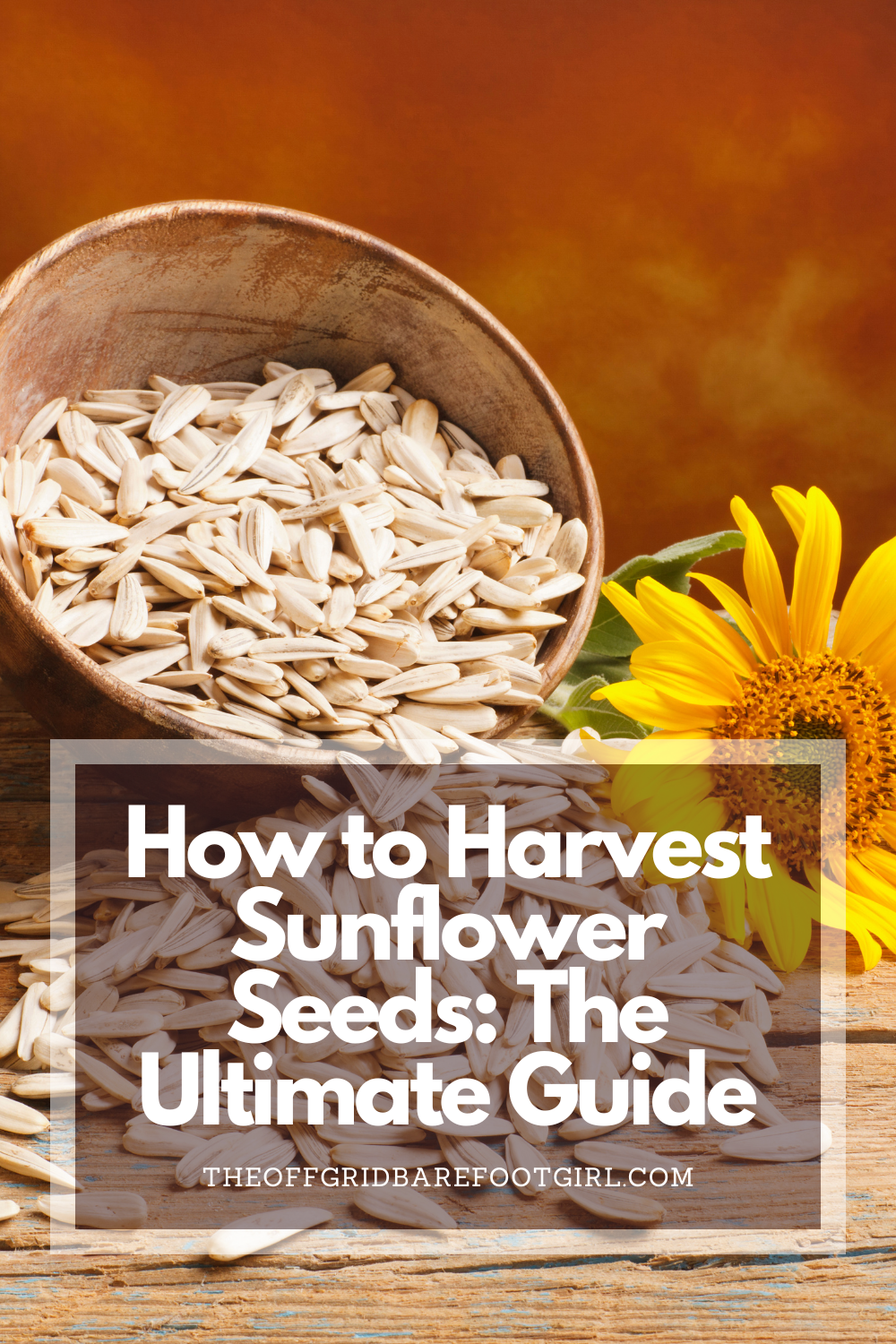
Frequently Asked Questions
1. When is the best time to harvest sunflower seeds?
Typically, sunflower seeds are ready for harvest when the back of the flower head turns brown and the petals begin to wilt or fall off. This usually occurs around 30 to 45 days after the flower has fully bloomed. However, it’s important to note that the timing may vary depending on the sunflower variety and growing conditions.
2. Can I harvest sunflower seeds from any type of sunflower?
While you can harvest seeds from most sunflower varieties, it’s recommended to choose seed-specific sunflower varieties for optimal results. These varieties are specifically bred to produce larger and more abundant seeds, making the harvesting process easier and more rewarding.
3. How do I properly store harvested sunflower seeds?
To ensure the longevity and freshness of your sunflower seeds, it’s important to store them correctly. After harvesting and properly drying the seeds, store them in airtight containers, such as glass jars or plastic containers, in a cool, dry, and dark place. Avoid exposing the seeds to moisture or extreme temperatures, as this can lead to spoilage.
4. Can I eat sunflower seeds straight from the flower head?
Although it’s possible to eat sunflower seeds straight from the flower head, they are typically easier to enjoy after the seeds have been separated and properly dried. Drying the seeds allows for better flavor development and a pleasant crunch. However, if you can’t resist the temptation, feel free to indulge in the freshly harvested seeds!
Summary
I hope I have inspired you to plant your garden with these tips and products.
If you were encouraged by this post, I invite you to check out my FREE Printables Page for fun free printables, planners, and charts.
ENTER MY FREE Printables Page HERE
Here are some more of my gardening inspiration posts to check out!
How to Grow Your Own Food Without a Backyard!
My Best Spring Garden Posts in One Spot!
Spring Garden Soil Prep: How to Improve Your Soil
Seed Starting Mix 101: Everything You Need to Know!
How to Plan a 200 Sq. Ft. Vegetable Garden Layout
How I Easily Start My Seeds Without Expensive Grow Lights!
How to Create a Smart Garden: Tech Meets Nature!
The Best Cheap Raised Vegetable Garden Beds
How to Grow Artichokes: Plant Once and Harvest for 5 Years!
The Best 8 Fast-Growing Vegetables In Just 45 Days!
From Snow to Sow: Plan Your Spring Garden Now!
11 Fun Ways to Brighten Your Spring Garden with Personality
Top 10 Spring Garden Crops to Harvest in 30 Days and Eat Now!
The Best Survival Crops for Caloric Survival
My Victory Garden: What I Learned from 5+ Years
Why Every Family Should Have a Victory Garden in Their Backyard Now!
The Best Perennials for a Long-Term Survival Garden
The Best Essential Oils for Plants That Repel Garden Bugs
More Gardening Projects!
How to Grow Green Garden Peas: Perfect Plump Peas!
Hugelkultur: Does This Epic Pioneering Method Actually Work?
9 Ways to Celebrate Earthing Day in Your Garden!
Gardening Indoors: Secrets of Growing Your Food Inside!
How to DIY a Milk Jug Drip Irrigation System!
Why Cedar Mulch Is The Perfect Natural Weed Barrier
Gardening Projects
Onions: How to Grow Onions for Storage
Peas: How to Grow Garden Peas for a Bumper Crop
Carrots: How to Grow Carrots for a Bountiful Harvest
Prep Your Garden for Spring Planting with These Expert Tips!
How to Grow a Prepper Garden to Survive and Thrive
The Best Garden Tools You Need for a Productive Season
Fastest Growing Vegetables for Your Survival Garden
How to Grow Marigolds As Pest Control In Your Vegetable Garden
Must-Have Tools for a Successful Balcony Vegetable Garden
How to Effectively Combat Powdery Mildew in Your Garden
The Best Tips for Organic Gardening
How to Release Ladybugs In Your Garden for Organic Pest Control
The Best Garden Snail Control Strategies
The Best Spring Vegetables to Grow in Your Garden
Seed Starter Mix: How To Make Your Organic Seed Starter Mix At Home
How to Grow a Productive Canning Garden
How to Plant and Grow a Salsa Garden
Easiest Heirloom Vegetable Seeds to Grow Now
How to Use the Hand Twist Claw Tiller: Tackling Tough Soil
More Fun Gardening Posts to Check Out!
Planning Your Garden: How to Plan a Vegetable Garden: Expert Green Thumb Tips!
Winterizing the Garden: How to Winterize Your Vegetable Garden: Step-by-Step Checklist
Mulching the Garden: How to Make Leaf Litter Mulch
Grow a Pumpkin Patch: How to Grow a Pumpkin Patch in Your Backyard
How to Grow a Fall Garden: 9 Best Fall Crops
Clever Ways to Incorporate Indoor Composting into Your Home
How to Start Composting for the Garden: A Step-by-Step Guide
The Ultimate Guide to Composting in Your Suburban Backyard
Why I Built A Survival Garden in My Backyard
16 Best Medicinal Herbs to Grow in Your Garden Now
Blessings,
The Off Grid Barefoot Girl

